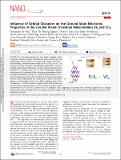Influence of orbital character on the ground state electronic properties in the van Der Waals transition metal iodides VI3 and CrI3
Abstract
Two-dimensional van der Waals magnetic semiconductors display emergent chemical and physical properties and hold promise for novel optical, electronic and magnetic “few-layers” functionalities. Transition-metal iodides such as CrI3 and VI3 are relevant for future electronic and spintronic applications; however, detailed experimental information on their ground state electronic properties is lacking often due to their challenging chemical environment. By combining X-ray electron spectroscopies and first-principles calculations, we report a complete determination of CrI3 and VI3 electronic ground states. We show that the transition metal-induced orbital filling drives the stabilization of distinct electronic phases: a wide bandgap in CrI3 and a Mott insulating state in VI3. Comparison of surface-sensitive (angular-resolved photoemission spectroscopy) and bulk-sensitive (X-ray absorption spectroscopy) measurements in VI3 reveals a surface-only V2+ oxidation state, suggesting that ground state electronic properties are strongly influenced by dimensionality effects. Our results have direct implications in band engineering and layer-dependent properties of two-dimensional systems.
Citation
De Vita , A , Nguyen , T T P , Sant , R , Pierantozzi , G M , Amoroso , D , Bigi , C , Polewczyk , V , Vinai , G , Nguyen , L T , Kong , T , Fujii , J , Vobornik , I , Brookes , N B , Rossi , G , Cava , R J , Mazzola , F , Yamauchi , K , Picozzi , S & Panaccione , G 2022 , ' Influence of orbital character on the ground state electronic properties in the van Der Waals transition metal iodides VI 3 and CrI 3 ' , Nano Letters , vol. 22 , no. 17 , pp. 7034-7041 . https://doi.org/10.1021/acs.nanolett.2c01922
Publication
Nano Letters
Status
Peer reviewed
ISSN
1530-6984Type
Journal item
Description
Funding: This work was performed in the framework of the Nanoscience Foundry and Fine Analysis (NFFA-MUR Italy) facility and was supported by JST-CREST (No. JPMJCR18T1). A part of the computation in this work, using the VASP code (43) in the GGA approximation (44), was performed by using the facilities of the Supercomputer Center, the Institute for Solid State Physics, the University of Tokyo and MASAMUNE-IMR, Center for Computational Materials Science, Institute for Materials Research, Tohoku University (Project No. 20K0045).Collections
Items in the St Andrews Research Repository are protected by copyright, with all rights reserved, unless otherwise indicated.

